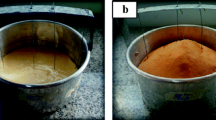Abstract
Baking is a decisive stage in the production of bakery products, in general—muffins, in particular—for most of the quality attributes of the final products depend on it. The aim of this work is to model the kinetics of muffin crust color development during baking and to evaluate the feasibility of this kinetic model to predict the baking times. Surface color is represented by the Browning Index, and the effect of baking temperature (from 140 to 220 °C) and process convective characteristics (natural convection, forced convection, and steam-assisted forced convection) are analyzed. Minimal baking times are calculated from experimental core temperature measurements. The modeling of browning kinetics, which incorporates the optimal crust color determined by sensory analysis, allows the estimation of optimal baking times. For all the tested conditions t op > t min, assuring a product whose inner structure was already totally baked. Finally, minimal, half, and optimal baking times present an exponential dependence with the oven temperature. Besides, there are no significant differences between both forced convection modes.




Similar content being viewed by others
References
Ahrné, L., Andersson, C. G., Floberg, F., Rosén, J., & Lingnert, H. (2007). Effect of crust temperature and water content on acrylamide formation during baking of white bread: steam and falling temperature baking. LWT - Food Science and Technology, 40(10), 1708–1715.
Broyart, B., Trystram, G., & Duquenoy, A. (1998). Predicting color kinetics during cracker baking. Journal of Food Engineering, 35, 351–368.
Buera, M. P., Lozano, R. D., & Petriella, C. (1986). Definition of colour in the non enzymatic browning process. Die Farbe, 32(33), 318–322.
Chhanwal, N., Indrani, D., Raghavarao, K. S., & Anandharamakrishnan, C. (2011). Computational fluid dynamics modeling of bread baking process. Food Research International, 44, 978–983.
Fehaili, S., Courel, M., Rega, B., & Giampaoli, P. (2010). An instrumented oven for the monitoring of thermal reactions during the baking of sponge cake. Journal of Food Engineering, 101, 253–263.
Garitta, L., Serrat, C., Hough, G., & Curia, A. (2006). Determination of optimum concentrations of a food ingredient using survival analysis statistics. Journal of Food Science, 71(7), S526–S532.
Hadiyanto, H., Asselman, A., van Straten, G., Boom, R. M., Esveld, D. C., & van Boxtel, A. J. B. (2007). Quality prediction of bakery products in the initial phase of process design. Innovative Food Science and Emerging Technologies, 8, 285–298.
Isleroglu, H., Kemerli, T., Sakin-Yilmazer, M., Guven, G., Ozdestan, O., Uren, A., et al. (2012). Effect of steam assisted baking on acrylamide formation and browning kinetics of cookies. Journal of Food Science, 77, E257–E263.
Lopez Osornio, M., Hough, G., Salvador, A., Chambers, E., IV, McGrawc, S., & Fiszman, S. (2008). Beef’s optimum internal cooking temperature as seen by consumers from diferent countries using survival analysis statistics. Food Quality and Preference, 19, 12–20.
Lostie, M., Peczalski, R., Andrieu, J., & Laurent, M. (2002). Study of sponge cake batter baking process: Part I. Experimental data. Journal of Food Engineering, 51, 131–137.
Mundt, S., & Wedzicha, B. (2007). A kinetic model for browning in the baking of biscuits: Effects of water activity and temperature. Lebensmittel-Wissenschaft und-Technologie., 40, 1078–1082.
Paton, J., Khatir, Z., Thompson, H., Kapur, N., & Toropov, V. (2013). Thermal energy management in the bread baking industry using a system modelling approach. Applied Thermal Engineering, 53, 340–347.
Purlis, E. (2011). Bread baking: Technological considerations based on process modeling and simulation. Journal of Food Engineering, 103, 92–102.
Purlis, E. (2012). Baking process design based on modelling and simulation: Towards optimization of bread baking. Food Control, 27, 45–52.
Purlis, E., & Salvadori, V. O. (2009a). Bread baking as a moving boundary problem. Part 1: Mathematical modelling. Journal of Food Engineering, 91, 428–433.
Purlis, E., & Salvadori, V. O. (2009b). Modelling the browning of bread during baking. Food Research International, 42, 865–870.
Sakin, M., Kaymak-Ertekin, F., & Ilicali, C. (2007). Simultaneous heat and mass transfer simulation applied to convective oven cup cake baking. Journal of Food Engineering, 83, 463–474.
Sakin-Yilmazer, M., Kemerli, T., Isleroglu, H., Ozdestan, O., Guven, G., Uren, A., et al. (2013). Baking kinetics of muffins in convection and steam assisted hybrid ovens. Journal of Food Engineering, 119, 483–489.
Schirmer, M., Jekle, M., & Becker, T. (2011). Quantification in starch microstructure as a function of baking time. Procedia Food Science, 1, 145–152.
Therdthai, N., Zhou, W., & Adamczak, T. (2002). Optimisation of the temperature profile in bread baking. Journal of Food Engineering, 55, 41–48.
Ureta, M., Olivera, D., & Salvadori, V. (2014). Quality attributes of muffins: effect of baking operative conditions. Food and Bioprocess Technology, 7, 463–470.
Vanin, F. M., Lucas, T., & Trystram, G. (2009). Crust formation and its role during bread baking. Trends in Food Science & Technology, 20, 333–343.
Xue, J., Lefort, G., & Walker, C. E. (2003). Effects of oven humidity on foods baked in gas convection ovens. Journal of Food Processing Preservation, 28, 179–200.
Zanoni, B., Peri, C., & Bruno, D. (1995). Modelling of browning kinetics of bread crust during baking. Lebensmittel-Wissenschaft and-Technologie, 28, 604–609.
Author information
Authors and Affiliations
Corresponding author
Rights and permissions
About this article
Cite this article
Ureta, M.M., Olivera, D.F. & Salvadori, V.O. Baking of muffins: Kinetics of crust color development and optimal baking time. Food Bioprocess Technol 7, 3208–3216 (2014). https://doi.org/10.1007/s11947-014-1292-z
Received:
Accepted:
Published:
Issue Date:
DOI: https://doi.org/10.1007/s11947-014-1292-z




